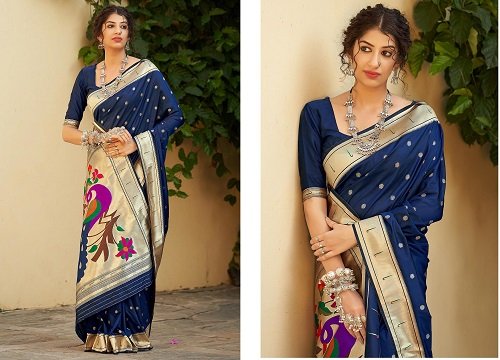India is a diverse country, not just in culture, religion and tradition, but also in handlooms, as each region has its own signature handloom which further depicts the history and culture of that region. Due to its detailed artistry, cultural relevance, and sustainable production methods, Indian handlooms have garnered substantial global interest in recent times. The global market for handwoven fabrics is rising in tandem with the growing appreciation for handmade goods and eco-friendly design. Therefore, these days you will find Indian dresses online which are being shipped and delivered all over the world. Here are the top three Indian handlooms that are becoming more and more well-known around the world.

Banarasi silk
One of the most famous, loved and luxurious Indian handlooms which is famous all across the world is the Banarasi silk and its origin is from one of the ancient cities in the world Varanasi, also known as Banaras, which is situated in the state of Uttar Pradesh in India. Famous for their intricate patterns, rich texture and brocade work, you will find a lot of attires in Banarasi silk, ranging from a saree to an Indian lehenga. Known for their elegance and rich sophistication, they have been in existence for ages now.
The exquisite zari (gold or silver thread) work, foliate and floral motifs, and fine engravings are the hallmarks of Banarasi silk. The duration of the weaving process varies based on the intricacy of the pattern, ranging from 15 days to six months. The attires, especially the sarees, are woven on a pure silk fabric in intricate designs giving a lustrous texture to the entire attire. The designs found on these attires are mainly influenced by Mughal art. Indian and international fashion designers are starting to favour Banarasi silk. Because of its luxurious appeal and ageless beauty you will find well embellished outfits in Banarasi silk appearing on international runways and in luxury boutiques. The choice of Banarasi sarees by celebrities like Anushka Sharma and Deepika Padukone for their weddings has generated excitement about this fabric throughout the world.
Moreover, this Indian handloom is versatile enough to be incorporated into contemporary Western designs and this is one of the main reasons why it is gaining popularity globally. It is noteworthy that Banarasi silk is making a comeback in the sustainable fashion world. These handwoven textiles have a substantially less carbon footprint than synthetic textiles that are mass-produced. Furthermore, the global trend towards ethical fashion is consistent with the support of handcrafted craftspeople.
Pochampally ikat
The distinctive dyeing method known as “Ikat,” in which the threads are dyed before weaving, is what makes Pochampally ikat, a native of the southern state of Telangana, famous. As a result, Pochampally ikat has its distinctive, somewhat hazy geometric designs. The intricate method of resist dyeing the strands and then weaving them into designs is how Pochampally ikat is made. The patterns are usually geometric, though there are also many floral and animal motifs. The tying and dyeing method must be done accurately and that too in different phases, if you desire to get the patterns and designs which you are seeking for. Ikat is a highly sought-after fabric in the international fashion business because of its unique visual appeal and the expertise needed to make it.
Because of the adaptability of Pochampally Ikat and the global interest with geometric patterns, it is not just utilised for traditional Indian clothes but also for modern Western clothing, accessories, and home décor. Pochampally Ikat has gained popularity among international designers because of its ethnic charm and ability to enhance modern designs with richness. The growing awareness of environmental issues has now become a global concern, and people are now switching to a sustainable lifestyle which discourages the trend of fast fashion. Since the Pochampally ikat is a sustainable option, therefore, it is one of the reasons why this Indian handloom is gaining global popularity. The production itself is eco-friendly as the weaving is done by hand, instead of energy producing machines. Because the ikat method frequently uses organic colours, it is even more appealing as a textile which is eco-friendly and sustainable.
Kanjeevaram silk
Kanjeevaram silk, originating from the Tamil Nadu temple town of Kanchipuram, is another Indian handloom that has garnered international recognition. Respected for its resilience, vivid hues, and elaborate patterns, Kanjeevaram silk is closely associated with customs and celebrations in Southern India. The silk sarees are renowned for its use of pure mulberry silk, rich and contrasting colour combinations, and temple border patterns.
The body and pallu of the saree, also known as the end piece, are woven separately and then are sewn together by experts. These sarees come with intricate motifs and patterns such as peacocks, parrots, temples, and mythological characters. Beyond its conventional limits, Kanjeevaram silk has gained popularity among brides and fashion enthusiasts worldwide. Since this Indian handlooms exude grandeur and elegance, therefore, it is one of the most preferred wedding attires by the South Indian brides and many women prefer to wear Kanjeevaram silk sarees to a festival, wedding or other similar occasions.
You will now find Kanjeevaram silk to be incorporated in western contemporary dresses, coats, and skirts by famous international brands and designers, thereby giving this conventional Indian handloom a modern touch. Kanjeevaram is weaved by hand, like Banarasi silk, to reduce its influence on the environment. Along with encouraging moral work habits, the sector also helps rural craftspeople, guaranteeing that their trade is passed down through the generations. These days, apart from sarees, lehengas, salwar suits and so on are also found in this fabric.


